英语语法 非谓语动词 特殊用法和做题七原则-江苏省盐城市2021届高三一轮复习(含答案)
- 格式:docx
- 大小:21.32 KB
- 文档页数:9
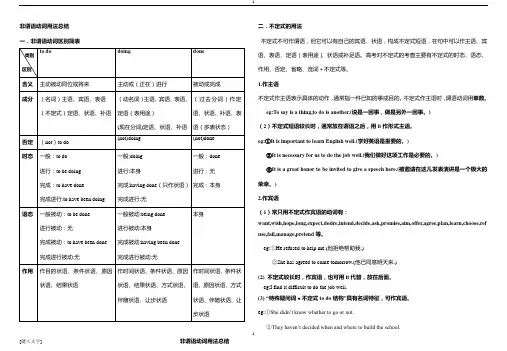
1非谓语动词用法总结一.非谓语动词区别简表二.不定式的用法不定式不可作谓语,但它可以有自己的宾语、状语,构成不定式短语,在句中可以作主语、宾语、表语、定语(表用途)、状语或补足语。
高考对不定式的考查主要有不定式的时态、语态、作用、否定、省略、连词+不定式等。
1.作主语不定式作主语表示具体的动作,通常指一件已知的事或目的。
不定式作主语时,谓语动词用单数。
eg:To say is a thing,to do is another.(说是一回事,做是另外一回事。
)(2)不定式短语较长时,通常放在谓语之后,用it作形式主语。
eg:①It is important to learn English well.(学好英语是重要的。
)②It is necessary for us to do the job well.(我们做好这项工作是必要的。
)③It is a great honor to be invited to give a speech here.(被邀请在这儿发表演讲是一个极大的荣幸。
)2.作宾语(1)常只用不定式作宾语的动词有:want,wish,hope,long,expect,desire,intend,decide,ask,promise,aim,offer,agree,plan,learn,choose,ref use,fail,manage,pretend等。
eg:①He refused to help me.(他拒绝帮助我.)②She has agreed to come tomorrow.(他已同意明天来.)(2) 不定式较长时,作宾语,也可用it代替,放在后面。
eg;I find it difficult to do the job well.(3) “特殊疑问词﹢不定式to do结构”具有名词特征,可作宾语。
eg:①She didn’t know whether to go or not.②They haven’t decided when and where to build the school.(4)不定式可作介but,except,besides“除……之外”的宾语,介词前有实义动词do的任何一种形式,后边的不定式就无to,否则必带to。
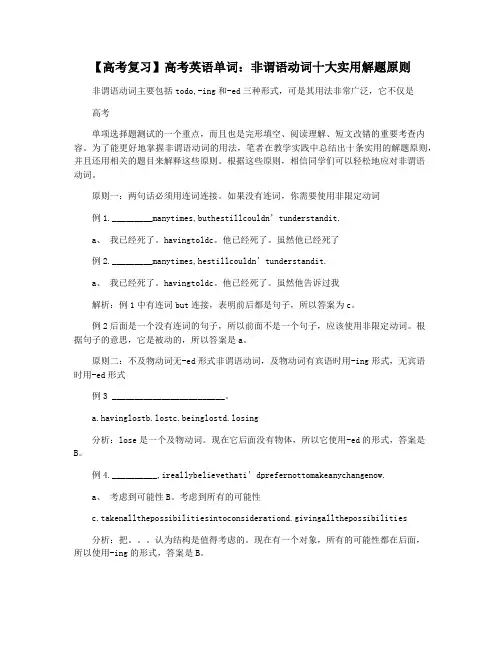
【高考复习】高考英语单词:非谓语动词十大实用解题原则非谓语动词主要包括todo,-ing和-ed三种形式,可是其用法非常广泛,它不仅是高考单项选择题测试的一个重点,而且也是完形填空、阅读理解、短文改错的重要考查内容。
为了能更好地掌握非谓语动词的用法,笔者在教学实践中总结出十条实用的解题原则,并且还用相关的题目来解释这些原则。
根据这些原则,相信同学们可以轻松地应对非谓语动词。
原则一:两句话必须用连词连接。
如果没有连词,你需要使用非限定动词例1._________manytimes,buthestillcouldn’tunderstandit.a、我已经死了。
havingtoldc。
他已经死了。
虽然他已经死了例2._________manytimes,hestillcouldn’tunderstandit.a、我已经死了。
havingtoldc。
他已经死了。
虽然他告诉过我解析:例1中有连词but连接,表明前后都是句子,所以答案为c。
例2后面是一个没有连词的句子,所以前面不是一个句子,应该使用非限定动词。
根据句子的意思,它是被动的,所以答案是a。
原则二:不及物动词无-ed形式非谓语动词,及物动词有宾语时用-ing形式,无宾语时用-ed形式例3 _________________________。
a.havinglostb.lostc.beinglostd.losing分析:lose是一个及物动词。
现在它后面没有物体,所以它使用-ed的形式,答案是B。
例4.__________,ireallybelievethati’dprefernot tomakeanychangenow.a、考虑到可能性B。
考虑到所有的可能性c.takenallthepossibilitiesintoconsiderationd.givingallthepossibilities分析:把。
认为结构是值得考虑的。
现在有一个对象,所有的可能性都在后面,所以使用-ing的形式,答案是B。

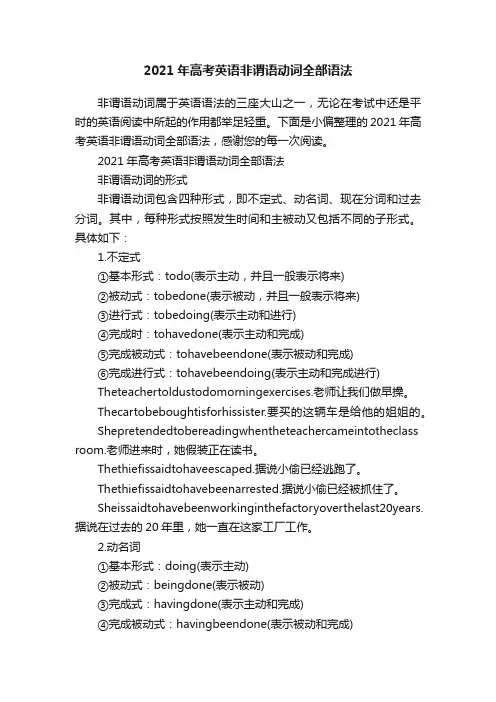
2021年高考英语非谓语动词全部语法非谓语动词属于英语语法的三座大山之一,无论在考试中还是平时的英语阅读中所起的作用都举足轻重。
下面是小偏整理的2021年高考英语非谓语动词全部语法,感谢您的每一次阅读。
2021年高考英语非谓语动词全部语法非谓语动词的形式非谓语动词包含四种形式,即不定式、动名词、现在分词和过去分词。
其中,每种形式按照发生时间和主被动又包括不同的子形式。
具体如下:1.不定式①基本形式:todo(表示主动,并且一般表示将来)②被动式:tobedone(表示被动,并且一般表示将来)③进行式:tobedoing(表示主动和进行)④完成时:tohavedone(表示主动和完成)⑤完成被动式:tohavebeendone(表示被动和完成)⑥完成进行式:tohavebeendoing(表示主动和完成进行)Theteachertoldustodomorningexercises.老师让我们做早操。
Thecartobeboughtisforhissister.要买的这辆车是给他的姐姐的。
Shepretendedtobereadingwhentheteachercameintotheclass room.老师进来时,她假装正在读书。
Thethiefissaidtohaveescaped.据说小偷已经逃跑了。
Thethiefissaidtohavebeenarrested.据说小偷已经被抓住了。
Sheissaidtohavebeenworkinginthefactoryoverthelast20years.据说在过去的20年里,她一直在这家工厂工作。
2.动名词①基本形式:doing(表示主动)②被动式:beingdone(表示被动)③完成式:havingdone(表示主动和完成)④完成被动式:havingbeendone(表示被动和完成)Travellinginspacebyordinarypeoplewillbecommoninthefutur e.在未来,普通人在太空旅行将会是普遍的事情。



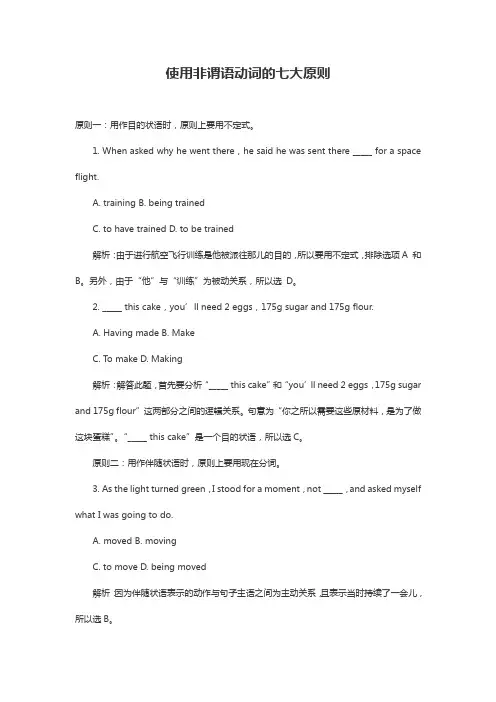
使用非谓语动词的七大原则原则一:用作目的状语时,原则上要用不定式。
1. When asked why he went there,he said he was sent there _____ for a space flight.A. trainingB. being trainedC. to have trainedD. to be trained解析:由于进行航空飞行训练是他被派往那儿的目的,所以要用不定式,排除选项A 和B。
另外,由于“他”与“训练”为被动关系,所以选D。
2. _____ this cake,you’ll need 2 eggs,175g sugar and 175g flour.A. Having madeB. MakeC. T o makeD. Making解析:解答此题,首先要分析“_____ this cake”和“you’ll need 2 eggs,175g sugar and 175g flour”这两部分之间的逻辑关系。
句意为“你之所以需要这些原材料,是为了做这块蛋糕”。
“_____ this cake”是一个目的状语,所以选C。
原则二:用作伴随状语时,原则上要用现在分词。
3. As the light turned green,I stood for a moment,not _____,and asked myself what I was going to do.A. movedB. movingC. to moveD. being moved解析:因为伴随状语表示的动作与句子主语之间为主动关系,且表示当时持续了一会儿,所以选B。
4. The girl was left alone in the room,_____ bitterly.A. to cryB. cryingC. criedD. cry解析:伴随状语表示的动作与句子主语之间为主动关系,选B。
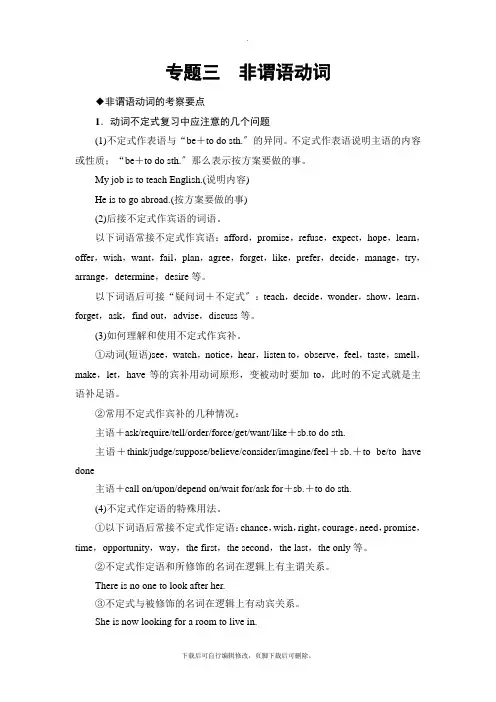
专题三非谓语动词◆非谓语动词的考察要点1.动词不定式复习中应注意的几个问题(1)不定式作表语与“be+to do sth.〞的异同。
不定式作表语说明主语的内容或性质;“be+to do sth.〞那么表示按方案要做的事。
My job is to teach English.(说明内容)He is to go abroad.(按方案要做的事)(2)后接不定式作宾语的词语。
以下词语常接不定式作宾语:afford,promise,refuse,expect,hope,learn,offer,wish,want,fail,plan,agree,forget,like,prefer,decide,manage,try,arrange,determine,desire等。
以下词语后可接“疑问词+不定式〞:teach,decide,wonder,show,learn,forget,ask,find out,advise,discuss等。
(3)如何理解和使用不定式作宾补。
①动词(短语)see,watch,notice,hear,listen to,observe,feel,taste,smell,make,let,have等的宾补用动词原形,变被动时要加to,此时的不定式就是主语补足语。
②常用不定式作宾补的几种情况:主语+ask/require/tell/order/force/get/want/like+sb.to do sth.主语+think/judge/suppose/believe/consider/imagine/feel+sb.+to be/to have done主语+call on/upon/depend on/wait for/ask for+sb.+to do sth.(4)不定式作定语的特殊用法。
①以下词语后常接不定式作定语:chance,wish,right,courage,need,promise,time,opportunity,way,the first,the second,the last,the only等。
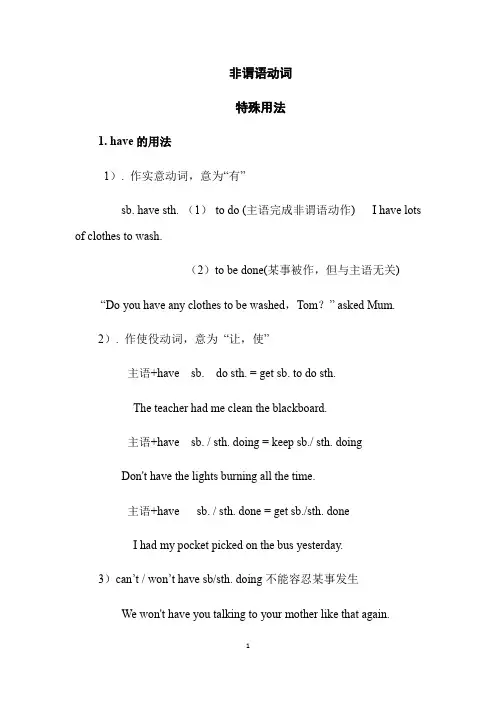
非谓语动词特殊用法1. have的用法1). 作实意动词,意为“有”sb. have sth. (1)to do (主语完成非谓语动作) I have lots of clothes to wash.(2)to be done(某事被作,但与主语无关)“Do you have any clothes to be washed,Tom?” asked Mum.2). 作使役动词,意为“让,使”主语+have sb. do sth. = get sb. to do sth.The teacher had me clean the blackboard.主语+have sb. / sth. doing = keep sb./ sth. doingDon't have the lights burning all the time.主语+have sb. / sth. done = get sb./sth. doneI had my pocket picked on the bus yesterday.3)can’t / won’t have sb/sth. doing不能容忍某事发生We won't have you talking to your mother like that again.2. 非谓语动词主动表被动1.)need/want/require/deserve +doing/to be done2.)be worth doing sth. 没有be worth being donebe worthy of being donebe worthy to be donebe worthwhile to do sth.be worthwhile doing sth.His good deed deserves praising/to be praised.=His good deed is worth praising.3.)sb. is to blame; sth. is to let(某物有待出租)The driver is to blame for the accident.4.)sth. is +adj. +to do 结构中,不定式与句子主语有动宾关系时,用不定式的主动形式5.)make sth. adj. to do6)feel/consider/find/believe/+sth. +adj. +to do7)be + adj. + to do sth.用于此类句型的形容词有:nice,easy,(un)fit,hard,difficult,important,(im)possible,(un)pleasant,interesting, (un)comfortable等The picture is pleasant to look at.The sentence is easy to understand.The water in the river is unfit to drink.I feel English not easy to learn well.3. be+过去分词+to do sth. 或be+过去分词+to(介词)+名词/doing 的用法:这个考点非常重要be lost in/ be equipped with /be devoted to/ be stuck in1) 当在句子中充当定语,状语或补语时,非谓语动词形式就是把be动词去掉。
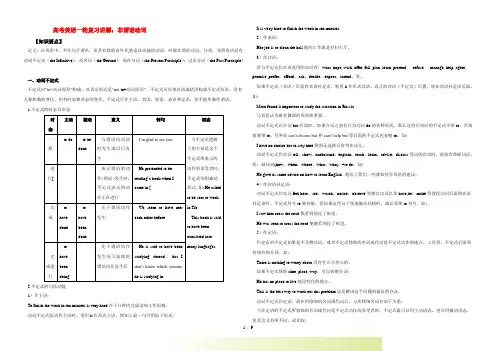
高考英语一轮复习讲解:非谓语动词【知识要点】定义:在英语中,不作句子谓语,而具有除谓语外其他语法功能的动词,叫做非谓语动词。
分类:非谓语动词有动词不定式(the Infinitive);动名词(the Gerund);现在分词(the Present Participle);过去分词(the Past Participle )一、动词不定式不定式由“to+动词原形”构成,其否定形式是“not to+动词原形”。
不定式可以带宾语或状语构成不定式短语,没有人称和数的变化,但有时态和语态的变化。
不定式可作主语、宾语、状语、表语和定语,但不能单独作谓语。
1.不定式的时态及语态时态主动被动意义例句语态一般to do to bedone与谓语动词同时发生或以后发生I’m glad to see you.当不定式逻辑上的主语是这个不定式所表示的动作的承受者时,不定式须用被动形式。
如:He askedto be sent to workin TibThis book is saidto have beentranslated intomany languages进行[表示谓语的动作(情况)发生时,不定式表示的动作正在进行He pretended to bereading a book when Icame in.[完成tohavedonetohavebeendone先于谓语动作发生We seem to have meteach other before.完成进行tohavebeendoing先于谓语动作发生而又延续到谓语动作发生后He is said to have beenstudying abroad,but Idon’t know which countryhe is studying in.2.不定式的句法功能1)作主语:To finish the work in ten minutes is very hard.在十分钟内完成这项工作很难。
高三一轮复习非谓语动词动词不定式(to do)、分词(现在分词v+ing,过去分词done)和动名词统称为非谓语动词。
现代英语将现在分词和动名词合为一大类叫作v + ing形式。
这些动词的形式不能在句中单独作谓语用,因而没有语法主语。
但可以有逻辑主语。
由于没有语法主语,也就不受人称和数的限定,因为不是谓语,也就没有时态和语态,但这些词仍能表示动作和状态,所以仍有表示与其他动词相对时间关系的形式。
由于与其它词有逻辑上的主谓关系,因此也有表示主、被动的形式,同时也有自己的宾语和状语,一起构成非谓语动词的短语(动词不定式短语,分词短语,动名词短语)。
非谓语动词在英语语法中占有特殊且重要的位置。
非谓语动词形式多样,应用广泛,且在句中起着很活跃的作用,也是语法项目中的重点和难点,学好非谓语动词,才能正确进行口语和书面的交流。
(一)1、动词不定式的形式变化:动词不定式有下列时态和语态的形式变化。
2.动词不定式的基本用法:动词不定式能起名词、形容词和副词的作用,可在句中作主语、表语、宾语补足语、定语和状语用.E.g. 1.做主语: To help each other is good.(动词不定式作主语时,一般可用it作形式主语,而将作主语的动词不定式置于句末,如:It is good to help each other.3..不定式作表语1)不定式作表语一般表示具体动作,特别是表示将来的动作。
To do two things at a time is to do neither.次做两件事等于未做。
4.动词不定式在句中作宾语,如带有宾语补足语时,须先用it作形式宾语,而将该动词不定式后置,如:I don’t think it right to do it that way.作定语:动词不定式作定语时,须位于被其修饰的名词或代词之后,如:Is this the best way to help him? 和定语用的动词不定式如果是不及物动词,不定式后面就要用必要的介词,如:He is the man to depend on. 如果被不定式修饰的名词为place, time, way,不定式后面的介词,习惯上可以省去,如:The old man is looking for a quiet place to live.作状语:动词不定式可以作下列的状语:①目的状语: Every morning he gets up very early to read English(二)ing形式:动词的ing形式也是一种非谓语动词。
非谓语动词分词:现在分词和过去分词一、现在分词形式1. 一般式(1)主动式doing (2) 被动式being done2. 完成式(1)主动式having done (2) 被动式having been done当非谓语动词的动作发生在主句谓语动作之前时,就用完成式。
当非谓语动词的动作发生在主句谓语动作之后时,或与主句谓语动作同时发生时,就用一般式。
二、何时用现在分词?1.vt. (及物动词)后有宾语时,非谓语动词用doing.2.vi.(不及物动词)非谓语动词用doing.3.vi.+介词+宾语时,非谓语动词用doing.三、过去分词形式done 表完成和被动;动词的过去分词有时相当于形容词。
四、何时用过去分词?vt. (及物动词)后没有宾语时,非谓语动词用done.五、分词做表语分词没有名词的性质,所以不能作主语。
但是分词有形容词的性质,可以作表语,多表明主语的特征性质或者状态等,可被very, quite, rather等副词修饰。
1. 现在分词即doing, 中文为“令人……”之意,主语多为物。
2. 过去分词即done, 中文为“感到……”之意,主语多为人。
过去分词一般表示被动或主语所处的状态。
常见分词有:astonishing/ astonished(惊奇); moving/ moved(感动); tiring/ tired(疲劳);disappointing/ disappointed(失望); puzzling/ puzzled(困惑); shocking/ shocked(震惊);boring/ bored(厌烦,厌倦); amusing/ amused(愉快,开心); exciting/ excited;satisfying/ satisfied(满足,满意)等六、分词做宾语补足语(一)现在分词做宾语补足语observe,notice, see, watch, look at, hear, find, keep, have, feel, get, catch, send, leave +sb./ sth. +doing sth.sb./ sth. 和doing之间存在主谓关系(主动关系),强调动作正在进行,尚未完成。
高考英语复习语法知识专题讲解8---非谓语动词(解析版)高考英语复习语法知识专题讲解专题八非谓语动词2.寻找逻辑主语寻找逻辑主语,,确定逻辑主语与所给动词之间的关系非谓语动词虽然不能作谓语,但仍具有动词的特点,其逻辑上的动作执行者就是逻辑主语。
分析非谓语动词与其逻辑主语(逻辑上的动作执行者)之间是主动关系还是被动关系(也就是看其逻辑主语是动作的发出者还是承受者)。
如果逻辑主语与非谓语动词之间是主谓关系,则用现在分词形式。
如果非谓语动词与其逻辑主语之间是动宾关系,则用过去分词形式。
但是当含有被动意义时,如果非谓语动词表示的动作尚未发生,则用动词不定式的被动式;如果非谓语动词表示的动作正在进行,则用现在分词形式的被动式。
[例2] The producer comes regularly to collect the cameras (return) to our shop for quality problems. [分析]returned句意:生产厂商定期来收集因质量问题而被退回到我们商店的相机。
句中已有谓语动词comes,因此设空处应为非谓语动词形式;且动词return与其逻辑主语the cameras之间是逻辑上的动宾关系,所以用过去分词作后置定语,故填returned。
3.分析所给动词表示的动作与谓语动词表示的动作发生的先后顺序非谓语动词所发生的时间是一个相对时间,即相对应谓语动词的动作发生的时间而言。
非谓语动词的形式不同,所指时间的含义也不同。
根据非谓语动词与谓语动词的动作发生的先后顺序确定用一般式还是完成式。
如to have done, having done表示该动作发生在谓语动词表示的动作之前;to be doing, doing表示该动作与谓语动词表示的动作同时发生。
[例3] (work) for two days, Steve managed to finish his report on schedule.[分析]Having worked考生容易误认为在句首设题,应填to work 表示目的。
高考英语一轮复习语法点专题讲解非谓语动词所谓非谓语动词,顾名思义也确实是不能单独用作谓语的动词(但与助动词结合可构成“进行时态、系表结构、完成时态、被动语态等谓语形式”),非谓语动词在英语句子结构中用法专门广泛、灵活,可充当主语、表语、宾语、补语、定语、状语等。
现在笔者向同学们作分类介绍:动词不定式一、不定式作主语1.一样置于句首:To see one time is better than to hear one hundred times.2.常见用it代替它作形式主语,而把不定式或不定式结构移到句尾:It's our duty to serve the people.3.在含有不定式作主语的疑问句或感叹句中,一样只用it作形式主语。
常见:Is it a good idea to plant some flowers there?不能够说:*Is to plant some flowers there a good idea?二、不定式作表语连系动词be,seem,appear,get,remain等常用不定式作表语,假如主语部分有实义动词do时,表语常可用不带to的不定式。
例如:My idea is to have a trip on Sunday.The only thing I can do now is wait at home.三、不定式作动词宾语1.动词+不定式:The girl asked to see the headmaster.常见的跟带to的不定式结构作宾语的动词有:agree,aim,arrange,ask,choose,decide, demand,pretend,expect,hope,learn,long,manage,offer,pretend,promise,refuse,wish,want,hate 等。
但help后的不定式常可省掉的,如:They helped(to)do the cleaning this morning.2.动词十疑问词(why除外)+不定式:We must find out what to do next.常见能跟“疑问词十不定式”结构作宾语的动词有:decide,find out,forget,know,learn,remember,see,think,understand,wonder等。
非谓语动词特殊用法1. have的用法1). 作实意动词,意为“有”sb. have sth. (1)to do (主语完成非谓语动作) I have lots of clothes to wash.(2)to be done(某事被作,但与主语无关)“Do you have any clothes to be washed,Tom?” asked Mum.2). 作使役动词,意为“让,使”主语+have sb. do sth. = get sb. to do sth.The teacher had me clean the blackboard.主语+have sb. / sth. doing = keep sb./ sth. doingDon't have the lights burning all the time.主语+have sb. / sth. done = get sb./sth. doneI had my pocket picked on the bus yesterday.3)can’t / won’t have sb/sth. doing不能容忍某事发生We won't have you talking to your mother like that again.2. 非谓语动词主动表被动1.)need/want/require/deserve +doing/to be done2.)be worth doing sth. 没有be worth being donebe worthy of being donebe worthy to be donebe worthwhile to do sth.be worthwhile doing sth.His good deed deserves praising/to be praised.=His good deed is worth praising.3.)sb. is to blame; sth. is to let(某物有待出租)The driver is to blame for the accident.4.)sth. is +adj. +to do 结构中,不定式与句子主语有动宾关系时,用不定式的主动形式5.)make sth. adj. to do6)feel/consider/find/believe/+sth. +adj. +to do7)be + adj. + to do sth.用于此类句型的形容词有:nice,easy,(un)fit,hard,difficult,important,(im)possible,(un)pleasant,interesting, (un)comfortable等The picture is pleasant to look at.The sentence is easy to understand.The water in the river is unfit to drink.I feel English not easy to learn well.3. be+过去分词+to do sth. 或be+过去分词+to(介词)+名词/doing 的用法:这个考点非常重要be lost in/ be equipped with /be devoted to/ be stuck in1) 当在句子中充当定语,状语或补语时,非谓语动词形式就是把be动词去掉。
2) 当在句子中充当主语,宾语或表语时,非谓语动词形式就是在be后加ing,即being。
4. seat,因为seat是vt. ,所以它的非谓语动词分为两种:1) 当seat后无宾语时,它的非谓语动词用seated=sitting;2) 当seat后有宾语时,即seat oneself时,它的非谓语动词用seatingoneself;5. do whatever/ everything/ what/ all/ anything one can/ could to do sth.= try /do one’s best to do sth. 尽某人最大努力做某事6. face的用法:1) 当face后有with时,它的非谓语形式永远是faced with.2) 当face后没有with时,它的非谓语形式永远是facing.7. 只要后面有介词by时,并且by的中文意思是“被”的时候,前面动词的非谓语动词用过去分词,即done.8. lack的用法:1) lack后有介词of时,lack永远是名词。
2) lack做动词时,永远是及物动词vt. ,只要后面有宾语,lack的非谓语动词永远就是lacking.3) be lacking in 时固定短语。
9.date back to= date from1) 在句子中做谓语动词时,永远用一般现在时。
2)在句子中做非谓语动词时,永远用ing形式。
10. consist of的非谓语动词永远用:consisting of=made up of11. 句型:adj.(形容词)+as +主语+be +to do sth.(这个动词必须用动词不定式)。
12. being done 作主语、宾语时,只表被动。
作定语、补语或状语时,被动+进行。
Being exposed to sunlight too much does great harm to the skin.He tried to avoid being noticed by others.The students watched the bike being repaired.13. to be done / being done /done 做后置定语的区别to be done 表将来被动being done 表正在进行被动done 表完成被动14.It is +过去分词+that +从句(这个句型可以转化为)= 主语+be+过去分词+ 1)to do2) to be done3) to be doing4) to have done5) to have been done15. 逗号后是不可以用动词不定式的The old lady got up before sunrise, walking along the beach and get some fresh air.但是如果中间是插入语,前后都有逗号,那么把后面的非谓语看作为紧跟在主句之后,表目的就用动词不定式。
The old lady got up before sunrise, as she often does, to walk along the beach and get some fresh air.15.remain 的用法:1.在句子中充当谓语时有一般现在时和一般过去时2.因为remain时vi. 所以在句子中充当非谓语时只能用ing形式,即remainingwith money remaining=with money leftthe remaining sth./sb.3.当remain的中文为1)仍然作为系动词,后面通常加adj.或n.做表语。
2)有待于后面通常加to be done16.include的用法including sb./sth.= sb./ sth. included17.there be +n.+ 1)doing sth. (当名词和后面的动词是主谓关系时)2)done (当名词和后面的动词是动宾关系时)pare的用法1)compare sth. to/ with sth.在句子中做非谓语时,用comparing,因为后面有宾语。
2)be compared to/with在句子中做非谓语时:(1)在句子中做定语,状语,补语时用compared to/with(2)在句子中做主语,宾语,表语时用being compared to/with19.make oneself done (understood/ heard)20.当两个句子之间是分号,句号或者有连词and,but,or otherwise等时,两个都必须是完整的句子,动词原型引导的句子叫祈使句。
21.做非谓语动词时,前后两个句子的主语通常要一致,不一致时要用独立主格结构。
做非谓动词遵循七原则原则一:用作目的状语,原则上用不定式。
(句首逗号,句中有逗号后不用动词不定式)原则二:用作伴随状语,原则上用-ing。
(常放主句后)原则三:用作结果状语,可用-ing/ to do,原则区别是:-ing 表示一定逻辑的结果,to do 表示非逻辑的结果。
(常放主句后)原则四:凡是有被动意义时,原则上要用过去分词(done)。
如果动作尚未发生,则用不定式的被动形式(to be done);如果动作正在进行,则用-ing的被动形式(being done)。
原则五:非谓语动词作状语时,原则上其逻辑主语应与主句主语保持一致。
原则六:强调动作发生在主句谓语动作之前,原则上要用完成式(-ing 的完成式having done或不定式的完成式to have been done)。
原则七:名词后作定语,原则上:不定式表示动作尚未发生;-ing表示动作正在进行;过去分词表示动作完成或被动。
总原则:不及物动词或及物动词后有宾语(除双宾动词),在句中作状语、定语、补语时用主动形式(doing);及物动词无宾语在句中作表语、定语、状语、补语时,常用过去分词短语done(关键是能识别及物动词与不及物动词)。